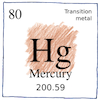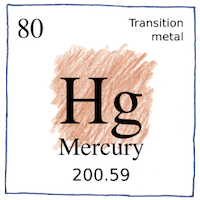China, India, Egypt
elements

|
Mercury
Water-silver hydrargyrum, associated with the Roman god of poetry and trade, liquid at room temperature, a diamagnetic heavy metal that you can’t cast into wings for your hat and heels.
Atomic number 80
Some alchemists considered mercury to be the first matter, the philosopher’s stone. Chinese and Tibetians, and, later, Grecians, used mercury as a medicine. In spite of its toxic effects, it is still used in eyedrops, vaccines, and dental amalgams. Grecians, Egyptians, and Romans used it in cosmetics, and is still used in mascara. Felt-makers used mercury in carroting pelts, producing felt hats and mad hatters. Miners used mercury to process silver ore and to trap flakes when panning gold. You can absorb mercury through your skin, inhale mercury vapor, or eat it in fish. It accumulates and is extremely toxic, impairing senses and coordination, disturbing sensations. Essential in neon, fluorescent, and mercury vapor lights, and used in thermometers and as electrodes in chemical processing.
Liquids
gin for grins beer for being wine for wit liquids for life tears for real ice is nice but that metal at room temperature should flow is plain weird



The alchemist’s prima materia was the matter from which all other matter was derived, and that would, on its touch, convert other matter to itself, a kind of ice-nine for all matter.
See also in The book of science:
Readings in wikipedia:
Other readings: